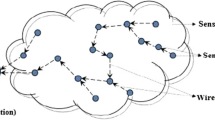Abstract
Prominently, DvHop-inspired range-free localization yields poor results due to ill-measured hop parameters (hop count, hop size). Therefore, instead of fully relying on hop parameters, proposed optimized localization in large-scale heterogeneous WSN (OLLHW) exploits the property of irregular communication range (ICR). Due to ICR, there are two different sets of nodes for an unknown node of interest (NOI): first, the sensors which cover NOI directly, i.e. antecedent set (AS) and second the sensors to which NOI covers directly, i.e. descendent set (DS). Thereafter, a centroid of AS reveals a notion of location which is further optimized the localization error such that notion should not go beyond the ideal communication range of DS. The OLLHW exercises linear optimization by eliminating hop size estimation and its flooding. Thus, OLLHW eliminates a complete communicational cycle. The OLLHW shows localization improvement in localization by 52 \(\mathrm{\%}, 37\mathrm{\%}, 27\mathrm{\%}, 18\mathrm{\%},\) and \(17\mathrm{\%}\) from DvHop, IDV, TR-DvHop, ODR, and HHOAM, respectively.








Similar content being viewed by others
Data availability
All data generated or analysed during this study are included in this published article.
References
Kumar S, Batra N, Kumar S (2022) Range-free Localization by Optimization in Anisotropic WSN. Springer, Singapore
Kumar S, Kumar S, Lobiyal DK (2022) MWLP-DP: mobile war-fighters location prediction for dark phase in internet of battlefield things. Trans Emerg Telecommun Technol 33(4):1–19. https://doi.org/10.1002/ett.4397
Kumar S, Batra N, Kumar S (2021) Range-independent localization for GPS dead zone in MWSN. Wirel Networks 27(7):4807–4823. https://doi.org/10.1007/s11276-021-02773-1
Niculescu B, Nath D, “Ad-Hoc positioning systems,” 2001. doi: /https://doi.org/10.1109/GLOCOM.2001.965964
Shen S, Yang B, Qian K, She Y, Wang W (2019) On improved DV-hop localization algorithm for accurate node localization in wireless sensor networks. Chinese J Electron 28(3):658–666. https://doi.org/10.1049/cje.2019.03.013
Kumar S, Kumar S, Batra N (2021) Optimized Distance Range Free Localization Algorithm for WSN. Wirel Pers Commun 117(3):1879–1907. https://doi.org/10.1007/s11277-020-07950-7
Cheikhrouhou O (2022) Regularized least square multi-hops localization algorithm based on DV-Hop for wireless sensor networks. Telecommun Syst 80:349–358. https://doi.org/10.1007/s11235-022-00897-z
Vauhkonen M, Vadâsz D, Karjalainen PA, Somersalo E, Kaipio JP (1998) Tikhonov regularization and prior information in electrical impedance tomography. IEEE Trans Med Imaging 17(2):285–293. https://doi.org/10.1109/42.700740
Kaur A, Gupta GP, Mittal S (2021) (2021) Comparative study of the different variants of the DV - hop based node localization algorithms for wireless sensor. Springer, US
Yang A et al (2022) The Improvement of DV-Hop Model and Its Application in the Security Performance of Smart Campus. Mathematics 10(15):2663. https://doi.org/10.3390/MATH10152663
Yanfei J, Kexin Z, Liquan Z (2020) Improved DV-hop location algorithm based on mobile anchor node and modified hop count for wireless sensor network. J Electr Comput Eng 2020:1–9. https://doi.org/10.1155/2020/9275603
Najeh T, Sassi H, Liouane N (2017) A novel range free localization algorithm in wireless sensor networks based on connectivity and genetic algorithms. Int. J. Wirel. Inf. Networks 25(1):88–97. https://doi.org/10.1007/S10776-017-0375-Y
Banihashemian SS, Adibnia F (2021) A novel robust soft-computed range-free localization algorithm against malicious anchor nodes. Cogn Comput 13(4):992–1007. https://doi.org/10.1007/S12559-021-09879-W
Hassan R, Cohanim B, De Weck O, Venter G (2005) “A comparison of particle swarm optimization and the genetic algorithm”, Collect. Tech. Pap. AIAA/ASME/ASCE/AHS/ASC Struct. Struct. Dyn. Mater. Conf. 2:1138–1150. https://doi.org/10.2514/6.2005-1897
Hadir A, Regragui Y, Garcia NM (2021) Accurate Range-Free Localization Algorithms Based on PSO for Wireless Sensor Networks. IEEE Access 9:149906–149924. https://doi.org/10.1109/ACCESS.2021.3123360
Kanwar V, Kumar A (2020) DV-Hop localization methods for displaced sensor nodes in wireless sensor network using PSO. Wirel. Networks. 27(1):91–102. https://doi.org/10.1007/S11276-020-02446-5
Kumar G, Rai MK, Saha R, Kim HJ (2018) An improved DV-Hop localization with minimum connected dominating set for mobile nodes in wireless sensor networks. Int J Distrib Sens Netw 14(1):155014771875563. https://doi.org/10.1177/1550147718755636
Bhat SJ, Venkata SK (2020) An optimization based localization with area minimization for heterogeneous wireless sensor networks in anisotropic fields. Comput Networks 179:107371. https://doi.org/10.1016/J.COMNET.2020.107371
Heidari AA, Mirjalili S, Faris H, Aljarah I, Mafarja M, Chen H (2019) Harris hawks optimization: algorithm and applications. Futur Gener Comput Syst 97:849–872. https://doi.org/10.1016/J.FUTURE.2019.02.028
Kumar S (2012) “An enhanced DV-Hop localization algorithm for wireless sensor networks,” igi-global.com, Accessed: May 25, 2022. [Online]. Available: https://www.igi-global.com/article/an-enhanced-dv-hop-localization-algorithm-for-wireless-sensor-networks/85003
Kaushik A, Lobiyal DK, Kumar S (2021) Improved 3-dimensional DV-hop localization algorithm based on information of nearby nodes. Wirel Networks 27(3):1801–1819. https://doi.org/10.1007/S11276-020-02533-7
Shahzad F, Sheltami TR, Shakshuki EM (2016) Multi-objective optimization for a reliable localization scheme in wireless sensor networks. J Commun Networks 18(5):796–805. https://doi.org/10.1109/JCN.2016.000108
Hill J, Szewczyk R, Woo A, Hollar S, Culler D, Pister K (2000) System architecture directions for networked sensors. ACM SIGOPS Oper Syst Rev 34(5):93–104. https://doi.org/10.1145/384264.379006
Karmarkar N (1984) “A new polynomial-time algorithm for linear programming,” In: Proeedings. Annual. CM Symposium. Theory on Computers. pp 302–311, Dec. 1984, doi: https://doi.org/10.1145/800057.808695
Powell MJD (1993) On the number of iterations of Karmarkar’s algorithm for linear programming. Math Program 62(1):153–197. https://doi.org/10.1007/BF01585165
Lei W, Xiaopeng W, Ax B, (2011) A New WSN Localization Algorithm Based on Regularization Method,” pp. 0–3
Author information
Authors and Affiliations
Corresponding author
Ethics declarations
Conflicts of interest
The authors have no conflicts of interests in any material discussed in this article.
Additional information
Publisher's Note
Springer Nature remains neutral with regard to jurisdictional claims in published maps and institutional affiliations.
Rights and permissions
Springer Nature or its licensor (e.g. a society or other partner) holds exclusive rights to this article under a publishing agreement with the author(s) or other rightsholder(s); author self-archiving of the accepted manuscript version of this article is solely governed by the terms of such publishing agreement and applicable law.
About this article
Cite this article
Kumar, S., Batra, N. & Kumar, S. Optimized localization in large-scale heterogeneous WSN. J Supercomput 79, 6705–6729 (2023). https://doi.org/10.1007/s11227-022-04922-5
Accepted:
Published:
Issue Date:
DOI: https://doi.org/10.1007/s11227-022-04922-5




